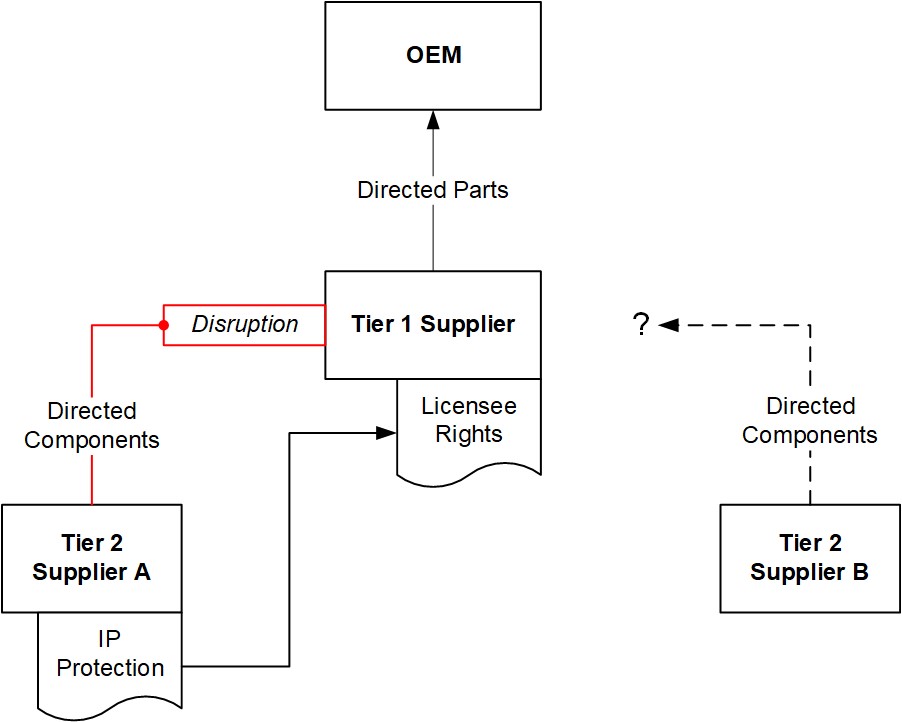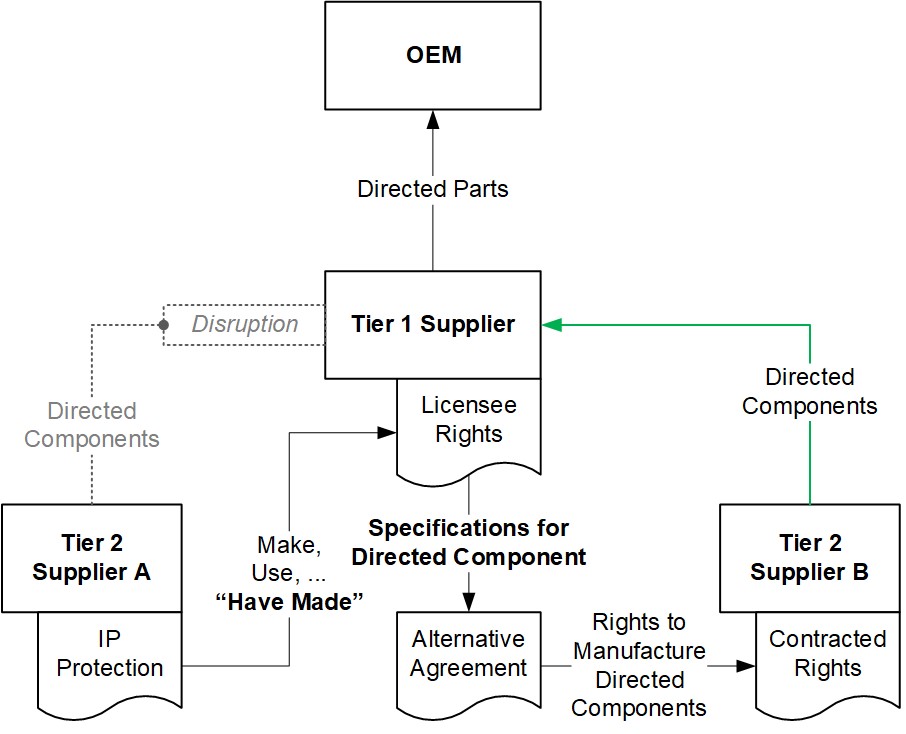Structuring IP Licenses to Manage Supply Chain Risks in the Automotive Industry
Auto Trends Series: Article 4

In recent years unexpected supply chain disruptions made it difficult for some automotive suppliers to manufacture components needed to fulfill their downstream orders on time and on budget. Although looking to alternate component sources may mitigate scheduling issues, an approach taken for expediency can expose the supplier and the substitute component source to significant risk of patent infringement claims. This article explains how these entities can use IP agreement tools such as conditional licenses and “Have Made” clauses to proactively manage such risks.
For the automotive industry in particular, single sourcing and other approaches that optimize supply chains for efficiency also may make the supply chains more susceptible to disruption. This is particularly true as automakers and their Tier 1 and Tier 2 suppliers integrate greater numbers of complex electronic components throughout various systems of the end vehicle. A disruption from a Tier 2 supplier can prevent the Tier 1 supplier from delivering their products on time or on budget, which may ultimately delay manufacturing and delivery of the end vehicle. Companies throughout the supply chain should consider IP risks when mitigating the impact of any potential supply chain disruption.
Intellectual Property Implicated in the Automotive Supply Chain
A supplier may have various IP rights covering a component supplied to a customer, typically including patents and trade secrets. Patents provide the supplier the right to exclude others from making, using, selling, or offering to sell products which are covered by the patent. Supplier trade secrets or “know-how” protect a supplier’s interest in confidential information for as long as the confidential information is properly kept a secret.
A patent allows a patent holder to restrict others from making, using or selling a patented invention for approximately 20 years
Trade secrets protect confidential information (e.g., composition, formula, pattern, compilation, customer lists, confidential sales information, program, device, method, technique, or process, etc.) for as long as the confidential information is properly kept secret.
In both patents and trade secrets (as well as other forms of IP), the owner retains the IP rights, unless granted as part of a license or some other agreement. These IP rights do not create an issue when a Tier 1 supplier buys its needed component parts from the entity that also holds the patent covering the components. But that changes when supply chain disruption forces a shift to using an alternate source of those component parts. Absent a license or other agreement providing for the Tier 1 supplier or alternate component supplier to freely use the original supplier’s IP, parties manufacturing patented products or using proprietary information risk being sued by the original supplier.
Automotive suppliers and OEMs are some of the most prolific patent filers in comparison to other verticals or industries. As such, companies which operate within the automotive industry should be especially cognizant of the IP rights of others as they enter into supply agreements.
Example of a Supply Chain Disruption
Illustrating the potential risks, take for instance the fact pattern illustrated in the diagram below. As shown, Tier 1 Supplier is supplying Directed Parts (e.g., an infotainment system of an automobile) to an automotive OEM under a Directed Supply Agreement. Tier 1 Supplier works with the Tier 2 Supplier A to incorporate Tier 2 Supplier A’s Directed Components (e.g., a display) into the Directed Parts. Tier 2 Supplier A has a patent protecting the Directed Components, but that patent creates no issues for Tier 1 Supplier that is buying the Directed Components from Tier 2 Supplier A because the supplier typically provides a limited license to the IP that covers the component.

Now change the hypothetical and assume a disruption occurs that prevents Tier 2 Supplier A from meeting its obligations for providing Directed Components to Tier 1 Supplier. If Tier 1 Supplier enters into an alternative supply agreement with Tier 2 Supplier B to manufacture that same display, would Tier 2 Supplier B infringe the patent rights of Tier 2 Supplier A? Additionally, would Tier 1 Supplier infringe the patent rights of Tier 2 Supplier A by manufacturing the infotainment system of the automobile, using or selling an infringing product (e.g., the Directed Components) manufactured by Tier 2 Supplier B? As is the case in many typical legal responses, the answer to these questions depends on the facts of each case.
The answer to the above-posed questions depends squarely on the scope of the license. Grantable rights under an IP license typically include the right to “make,” “have made,” “use,” or “sell” a protected component. At a minimum, the agreement between Tier 2 Supplier A and Tier 1 Supplier would provide Tier 1 Supplier “use rights” for the Directed Components. This essentially allows Tier 1 Supplier to use the Directed Components as part of manufacturing the Directed Parts, and is part and parcel with a supply agreement. However, if no further rights to the Directed Components are granted under the agreement, such as “make” or “have made” rights, Tier 1 Supplier would risk a lawsuit by Tier 2 Supplier A should Tier 1 Supplier make the Directed Components themselves or have the Directed Components made by a third-party (e.g., Tier 2 Supplier B). Further, Tier 2 Supplier B would similarly risk a lawsuit by Tier 2 Supplier A should Tier 2 Supplier B make or sell the Directed Components to Tier 1 Supplier.
Given these risks, a customer can limit future litigation resulting from supplier breach by negotiating for IP licenses that more effectively account for potential disruptions in the supply chain. A supplier granting such licenses may negotiate greater compensation for the agreement, and may also build goodwill with the customer/OEM by providing them with an alternative in the event of a disruption. Importantly, not having a thoughtful license in the supply agreement can result in lost profits to the supplier, potential IP litigation implicating both the customer and the alternative supplier, and a risk of breaching the supply agreement between the customer and OEM. As such, all parties in the supply chain have a vested interest in ensuring that the supply agreement between the customer and original supplier considers and addresses IP issues stemming from a supply chain disruption.
Proactively Mitigating IP Risks for Supply Chain Disruptions
Two exemplary provisions that could be included in a supply agreement between a customer and supplier include a “Have Made” clause and a conditional license. These provisions, defined more fully below, benefit all parties of the supply chain.
Continuing the same example from above, and as illustrated below, if a supply agreement for the display contains one or both of these provisions, Tier 1 Supplier can source the display from Tier 2 Supplier B, thus being able to fulfill its obligations under the Supply Agreement to supply the infotainment system to the automotive OEM. Tier 2 Supplier A can receive royalties or fees from the Tier 1 Supplier, even after a disruption which triggers performance under the conditional license or the have made clause. Tier 2 Supplier B can manufacture the display for the Tier 1 Supplier without the risk of infringing the IP of Tier 2 Supplier A.
In this scenario, Tier 2 Supplier B will want to ensure that the supply agreement between Tier 1 Supplier and Tier 2 Supplier B contains sufficient representations and warranties that require a “Have Made” clause or conditional license exist between the Tier 1 Supplier and Tier 2 Supplier A, so that Tier 2 Supplier B can manufacture the directed components. Tier 2 Supplier B also should ensure that Tier 1 Supplier indemnifies Tier 2 Supplier B against any lawsuits filed by Tier 2 Supplier A.

“Have Made” Clause
IP licenses generally grant licensees rights relating to commercializing licensed products, such as using and selling the licensed products. A “Have Made” clause in a license specifically grants the licensee the ability to “have made” the licensed product (i.e. in addition to making the licensed product themselves and selling the licensed product). The “Have Made” clause should consider and include the following rights and obligations under the license:
- Any conditions on the grant of the “Have Made” rights (similar to the conditional license discussed below).
- Schedule of any specific IP which covers the licensed product, any royalty to be paid to the licensor by the licensee and/or third-party manufacturer.
- A duration of such rights granted to the licensor.
- A covenant not to sue the licensee or any third-party engaged by the licensee to have made the licensed product.
By granting the “Have Made” right to the licensee, the licensor cannot sue the licensee if the licensee has the licensed product manufactured by a different supplier. Even if a covenant not to sue a third-party which manufactures the licensed product were absent from the agreement, as noted in several cases, the “Have Made” right also transfers to third-party suppliers which may manufacture the licensed product, thus insulating the third-party suppliers from lawsuits by the licensor stemming from the manufacturing of the licensed product. See, e.g., Intel Corporation v. Broadcom Corporation, 173 F. Supp. 2d 201 (D. Del. 2001); Asetek Holdings, Inc. v. Coolit Systems, Inc., No. C-12-4498 EMC (N.D. Cal. Jun. 16, 2014); Tulip Computers International v. Dell Computer Corporation, Civil Action No. 00-981-KAJ (D. Del. Feb. 4, 2003). Under the “Have Made” rights granted to the customer, both the customer and the third-party supplier are insulated from intellectual property litigation from the supplier.
Conditional License
A conditional license is a clause in the supply agreement which grants a licensee the right to the IP covering the licensed product when certain predefined conditions occur, typically in exchange for some royalty or fee. Similar to the “Have Made” clause, conditional license should avoid all ambiguities regarding the conditions which trigger grant of the license, the IP that covers the licensed product, the duration of the grant, and any royalty owed by the customer to the supplier. Further, the customer should ensure that the conditional license grants the customer the right to manufacture the component itself or to have the component made by a third-party supplier (e.g., similar to the have made clause described above). Under a conditional license, the licensor would retain all IP rights subject to performance or occurrence of the particular condition.
Continuing our example above, if the supply agreement contained a conditional license which triggers when Tier 2 Supplier A breaches or threatens a breach, any breach or threatened breach (such as Tier 2 Supplier A requesting a unilateral price increase, threatening to breach or failing to deliver under the Supply Agreement) would trigger granting of the conditional license. Once the conditional license is granted to Tier 1 Supplier, Tier 1 Supplier can exercise their rights granted under the conditional license to make themselves (or have made) the Directed Component. Additionally, under the terms of a well-crafted license, the licensor would receive a royalty (e.g., from Tier 1 Supplier and/or Tier 2 Supplier B) and both the licensee and the alternative supplier would be risk-free of patent litigation from Tier 2 Supplier A relating to the Directed Component.
Benefits and Drawbacks
Suppliers benefit in different ways under these arrangements than customers. For instance, a supply agreement that grants a conditional license achieves different results than a license within the supply agreement that grants “Have Made” rights to the customer:
- The conditional license is likely more attractive to suppliers, since the supplier retains all exclusive rights to their IP, so long as they fulfill their requirements under the supply agreements. The customer’s ability to have the product manufactured by third-party suppliers or to manufacture the product in-house is limited to those specific conditions, and thus an unexpected occurrence may result in the customer’s inability to make or have the product made.
- “Have Made” rights are more attractive to the customer, as they provide the customer security to shop manufacturing the product to alternative suppliers, should the customer anticipate a breach or a lack of ability to fulfill a larger order. Depending on the negotiating positions of the parties, the “Have Made” clause may also require that the substitute source (Tier 2 Supplier B in our example) pay a royalty on the components.
Conclusion
All companies within the automotive supply chain should consider IP implications when entering into supply agreements, whether the company is a customer, original supplier, or an alternative supplier. This can avoid costly IP litigation and can provide the original supplier with a revenue stream from royalty or fees under the supply agreement. The authors of this article are available to assist in analyzing your supply chain contracts for potential IP concerns.
Subscribe to the Auto Trends 2023 Series
For an ongoing discussion of where the industry is going, we invite you to subscribe to this Auto Trends 2023 Series by clicking here.


